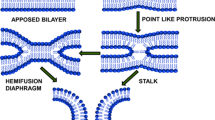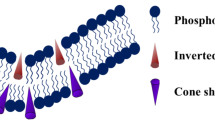Abstract.
Membrane fusion constitutes a pivotal process in eukaryotic cell physiology. Both specialized proteins and membrane lipids play key roles in fusion. Here, our current understanding of the mechanism of membrane fusion is reviewed. The focus is on the relatively simple and well-understood proteinaceous fusion machinery of enveloped viruses and the physical properties of lipids that appear to be of great relevance for fusion progression. Recent observations suggest that viral fusion proteins use packed conformational energy and bilayer-destabilizing domains to (i) bring participating membranes into intimate contact, (ii) merge proximal lipid monolayers through highly curved stalk/hemifusion intermediates, and (iii) generate a lipid-containing fusion pore, thereby terminating the fusion process.
Similar content being viewed by others
Author information
Authors and Affiliations
Additional information
Received 4 January 2002; received after revision 3 April 2002; accepted 5 April 2002
Rights and permissions
About this article
Cite this article
Basañez, G. Membrane fusion: the process and its energy suppliers. CMLS, Cell. Mol. Life Sci. 59, 1478–1490 (2002). https://doi.org/10.1007/s00018-002-8523-6
Issue Date:
DOI: https://doi.org/10.1007/s00018-002-8523-6




